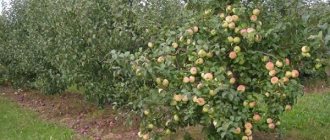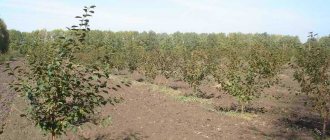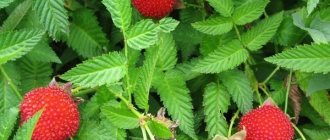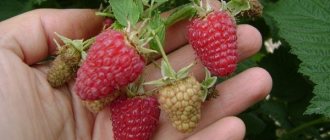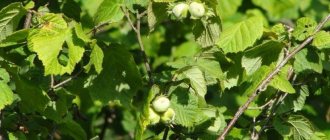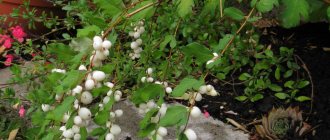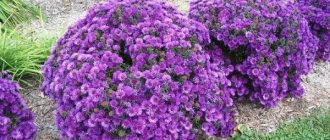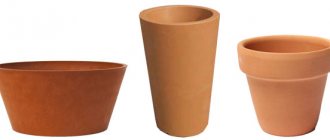Plants » Flowers
0
347
Article rating
Kira Stoletova
Euphorbia cypress is a paradoxical flower. On the one hand, this is an invasive plant, banned in many countries, and on the other hand, it is a landscape designer’s dream. It is considered one of the most effective biological agents for treating skin, and at the same time it has a detrimental effect on horses and cows.
Euphorbia cypress
Origin
The history of this flower goes back 3500-3000 years. His image is found in Bronze Age excavations in Central Europe. Later it spread throughout Europe, with the exception of the northern part, and also in Asia (Turkey). In 1860, it was brought to the USA as an ornamental plant.
Euphorbia cyparissias is the biological name of the cypress-leaved milkweed.
The plant has adapted to a wide range of growing conditions. At first it was used as a cover flower on graves. Hence the popular names:
- Euphorbia in the cemetery;
- cemetery moss;
- Bonarparte's crown.
Grows in sparse forests, on roadsides and in pastures in Western Europe and the USA. Euphorbia cyparissius is toxic to horses and cows and fatal to fish.
It is included in the list of noxious weeds by the North American Department of Agriculture and is prohibited for cultivation in the states of Colorado, Connecticut, Massachusetts and Wisconsin. But, despite the strict ban, the plant continues to be planted as an ornamental.
It is from the cypress milkweed that the concept of a sensory garden comes from - its fluffy stems are so beautiful and the incredibly soft foliage is so pleasant to the touch. According to landscapers, this is one of the most spectacular cover species, also unpretentious, flexible and with an excellent growth rate.
Description
Euphorbia cyparissias is a vigorous spreading rhizomatous perennial plant with upright stems up to 30 cm tall, with very narrow blue-green leaves resembling cypress needles.
Leaves and flowers
In the lower part, the stem is unbranched, covered with short, tightly pressed scale-like leaves 2.5 - 3 cm long. In the upper half, it forms lateral, densely leafy shoots, ending in an umbrella inflorescence of 10-18 greenish-yellow flowers, becoming orange on poor soils. In good weather, it blooms again in early autumn.
The flowers are arranged in pairs (the female flower is on a short stem above the male flower). They lack sepals and petals. Under the flowers, 3 mm in diameter, there are yellowish-green bracts 6 mm in diameter.
Female flowers produce fruit in the form of a capsule of 3 sections, about 3 mm in diameter, each containing 1 seed. When ripe, the seeds “shoot” at a distance of up to five meters from the plant.
Roots
The root system consists of:
- from a taproot growing vertically down to a depth of 3 m;
- lateral roots with additional buds capable of forming new shoots.
The extensive root system and early spring growth allow weak-looking leafy shoots to compete for space, nutrients, water and sunlight, crowding out other plants.
If cypress spurge is not limited, by the age of 5-6 years it will cover an area with a diameter of 1.5-2 meters with a dense carpet.
All parts contain toxic latex, which irritates the mucous membranes and gastrointestinal tract and causes dermatitis on contact in some people.
It was once used to remove freckles, kill warts and skin sores, and promote hair growth. With the development of cosmetology, the need for it disappeared.
Rules for caring for cypress spurge
When planting and caring for cypress milkweed, you need to follow several rules to ensure active growth and lush flowering twice a year.
The plant tolerates moisture deficiency very well and quickly adapts to prolonged drought. But excessive watering causes serious harm to it. Euphorbia needs additional moisture only in hot weather with rare precipitation. If the foliage has faded and the plant has lost its attractiveness, this is a signal of a lack of moisture.
Young seedlings also require additional watering - this speeds up the rooting process. To moisten, you can use a regular garden watering can, but you need to carefully monitor the volume of water and not allow the cypress milkweed to become waterlogged.
The perennial grows well without fertilizing. To improve its decorative qualities, you can fertilize it with organic matter - peat or humus - in April or early May. If cypress spurge is grown on poor soil, it can be fed 2-3 times a summer with a liquid solution of humus or complex mineral fertilizers.
Pruning and loosening the soil
Regular loosening of the soil is very important for the health and beauty of cypress milkweed. It helps not only to get rid of weeds, but also to improve oxygen access to the root system of the plant.
Regular pruning will help maintain a neat and attractive appearance of cypress milkweed. Without it, the bush grows very quickly, turning into an inconspicuous plant.
In addition, it is pruning that stimulates the re-blooming of milkweed, which, depending on climatic conditions, can be observed in August or September. Pruning is best done after flowering, removing all dry and damaged shoots. Stems with traces of rot, disease or insect damage are also removed.
Cypress spurge is a perennial garden plant that has won the love of many gardeners due to its decorative appeal and unpretentious “character”. With minimal care you can get a lush, spectacular plant that can decorate any flower bed, rockery or flower garden.
Purchase and adaptation
Seedlings easily adapt to a new location
The plant goes on sale both in a container with a formed bush, and in the form of one stem and part of the rhizome.
A seedling with a closed root system (ZRS) can be planted in open ground at any time of the year, the only condition is no later than 2 months before the onset of permanent frosts.
A stem with an open root system (ORS) needs adaptation operations.
To do this you need:
- remove dried roots;
- immerse the stem in the root solution for several hours.
When and how does it bloom
The flowering of milkweed is not very noticeable against the general background of the bush, but it is very abundant. The main characteristic feature of cypress milkweed is the yellow-green hue of the flowers. They are only a few shades lighter than their lush crown. The inflorescences are located at the very top of the stem and are shaped like an umbrella. Small flowers consist of two large and most pronounced petals. Their shape resembles a bow tie, but with pointed ends.
Flowering period
The bush begins to bloom in the second half of May, but if the year turns out to be warmer, then the spurge will begin to bloom buds earlier. This process lasts about 1.5 months; with proper care, the bush can bloom again.
Landing
The seedlings do not have a clearly defined main rhizome; they are placed in shallow (up to 5 cm) grooves with drainage at the bottom, straightening the lateral roots.
Sprinkle light soil on top, lightly compact and moisten the soil surface.
When planting an adult plant that has a tap root, dig a hole 30-40 cm deep. Similar operations follow.
Transfer
You can replant both the mother plant with a powerful taproot and the rooted parts with lateral rhizomes.
To do this, cut off the roots with a sharp shovel, dig up the spurge and, together with a lump of earth, transfer it to the prepared place.
If the vertical rhizome could not be dug up completely, then new shoots will soon sprout from it.
Optimal time for transplantation:
- early spring, before sap flow begins;
- autumn, 1.5 - 2 months before persistent cold, so that the plant can take root.
The necessary conditions
Euphorbia has inhabited open areas with poor soil: pine forests, hills, fields. Its natural habitat is limestone, sandy or gravelly soils. It is drought tolerant and loves sun but tolerates partial shade.
Selection of soil and location
To plant euphorbia in the garden, you need a dry, sunny place with a rocky, loose substrate. She will feel great in rock gardens, mixborders, and arabesques.
This plant does not tolerate:
- constantly damp soil;
- nearby groundwater;
- stagnation of moisture after melting snow or rain.
Therefore, for planting, choose an elevated place, with poor rocky or sandy soil and good drainage.
Humidity
The plant is drought-resistant. It calmly tolerates long-term lack of watering due to:
- narrow leaves through which moisture evaporates weakly;
- a long taproot that obtains water from a sufficient depth.
During periods of insufficient moisture, spurge is able to store it mainly in the rhizome.
This is confirmed by the data provided in the fire interaction information system FEIS (USA):
- with a decrease in watering, the number of rhizomes in the plant increased;
- the thickness of the main stem increased by 15%.
At high air temperatures, it is enough to moisten the soil around the flower once every 7-10 days.
Excessive moisture is detrimental to milkweeds. It can lead to the death of the plant.
Temperature
Little cypress survives in a wide range of temperatures: from 40°C to -25°C. During hot weather, it needs to be additionally moistened, and before the winter cold, the entire above-ground part must be cut off.
Even if the stems of the plant dry out in the hot summer or freeze in the winter, the spurge will be reborn from dormant buds located on the horizontal roots.
Lighting
Like any plant, euphorbia loves the sun. Its decorative qualities fully develop in a sunny place:
- needle leaves densely cover the stem, creating a fluffy dense shoot;
- stems are low, strong, growing vertically;
- the color of leaves, stipules and flowers is rich;
- The shape of the bush is symmetrical, spherical.
In light shade, these qualities are largely preserved, but the color intensity decreases, and the height of the stems and the distance between the rows of leaves on them increases.
In the shade, the stems grow long and weak. The bush falls apart and loses its shape. The color of all parts of the plant becomes faded.
Grows well in full sun
Home care
Fertilizers and fertilizers
An excess of organic matter and nitrogen in the soil leads to a deterioration in the decorative qualities of cypress euphorbia - the shoots become long, weak, and lodging. As a result, the number of leaves per unit area of the stem decreases, and it looks “naked.”
To add fluffiness and compactness, it is recommended to use potassium and phosphorus fertilizers, but no more than 2 times per season:
- at the beginning of the growing season - potassium nitrate, potassium sulfate;
- in autumn - superphosphate.
On poor soils or when growing for a long time in the same place, you can sprinkle a complete complex fertilizer in early spring, while still on the snow, at the beginning of its melting.
The nitrogen content in spring should not be more than 20%. The optimal mixture for feeding is NPK 20-20-20.
Watering
Water the garden spurge as the surface layer dries completely.
When watering this plant, they adhere to the principle “It is better to underwater than overwater.” Particular care must be taken to ensure that water after watering does not stagnate around the euphorbia.
Use in landscape design
Cypress spurge adds subtle and delicate texture to garden arrangements.
Because the stem is densely covered with foliage down to the ground, it can be used as a foreground flower. It goes well with conifers - low-growing spruce, juniper and fir. But the euphorbia bushes themselves look great, and at any time of the year.
With these plants, garden compositions become elegant and impressive, especially on a rocky site, in a rocky garden.
In order for milkweed to always look decorative, it must be trimmed regularly. The first time this operation is performed is after the end of flowering, but before the formation of fruit pods. Then the cutting is carried out as the shoots grow or to maintain the given shape. As a result of pruning, the bush becomes denser and fluffier.
Containing Aggression
To prevent cypress milkweed from spreading throughout the entire area, it is planted in sunken pots or the growth area is limited with special dug-in barriers.
Medicinal properties
Euphorbia cypress is a poisonous plant. Its white juice has properties comparable to snake venom. But the correct use of juice in diluted form in the right dosage is used as a medicine.
Even in Ancient Egypt and Greece, this herb was used for treatment. Often not only the juice of the plant is used, but also its seeds. The seeds contain healthy fats that are used in homeopathy.
Main medicinal properties:
- external use of milkweed juice helps get rid of warts and calluses on the skin, removes spots and freckles, treats ringworm, heals wounds;
- alcohol tinctures are used to treat diseases of the stomach and lungs, and they also help reduce rheumatic pain;
- warm herbal baths are used to get rid of nail fungus;
- milkweed tincture has antibacterial properties and is used to fight cancerous tumors of internal organs;
- an aqueous infusion of the herb is a laxative and vomiting agent; it is also used to remove worms and treat the kidneys and stomach.
Reproduction methods
Euphorbia cyparissias has great reproductive potential.
Methods used at home:
- seminal;
- vegetative (cuttings);
- regenerative (through fragments of rhizomes, horizontal roots).
As biology students at the University of Roy Island found out, any broken part of the cypress milkweed can reproduce vegetatively.
Seeds
Seeds can be sown before winter, covered with a 2-centimeter layer of loose substrate consisting of garden soil and sand, or in early spring. Seeds are not stratified before planting.
Cuttings
Optimal time for cutting: late May - early June. For cuttings, choose young shoots with more than 20 leaves.
Next, perform the following operations, always wearing protective gloves:
- cut off the upper part of the stem with 10-15 leaves with a sharp knife;
- wash off the latex layer from the cutting with warm water;
- fill the cut areas of the cuttings and the mother plant with crushed activated carbon;
- cut branches are placed in a warm place to dry for 1-2 days;
- planted in a mini-greenhouse.
The planting container is filled with a drainage layer (2-3 cm), then with soil in equal proportions:
- garden soil;
- sand.
It is useful to add a few crushed tablets of activated carbon.
The soil should be slightly moist: spurge does not tolerate excessive moisture.
After a month, the cuttings will take root and can be planted in the garden. To keep the roots strong and healthy, use root-forming solutions - Kornevin, Heteroauxin.
Dividing the bush
If euphorbia is already growing in your garden, it is most convenient to propagate it by division. The operation is carried out in April-May, when flowering begins.
No special skills are required here: each division has at least 2 buds.
You just need to separate the division along with part of the horizontal root and replant it in a previously prepared place.
Vegetative regeneration
Shoots can develop from any, even deeply buried part of the root. Students at the University of Roy Island noted how from 2 parts of living roots they grew the following year:
- 240 branches from the main rhizome;
- 160 – from horizontal.
The fastest propagation of Euphorbia cypressifolia is through regeneration.
Origin and botanical description of the plant
The cypress type of milkweed is a perennial. Euphórbia cyparissias has the following features:
- maximum height of the bush – 40 cm;
- the root system is branched, spreading on the soil surface, facilitating rapid coverage of the area;
- the stems branch at the base, the thickness does not exceed 5 mm, the peduncle is located only at the top;
- needle leaves, atypical for most conifers, soft, dark green, approximately the same size within 2 cm;
- flowering - once every 1-2 years, the shade of the bud is pinkish or yellow, there is a three-leaf capsule with seeds inside, after the end of the flowering phase, fruits with three oval-shaped lobes are formed.
Despite the fact that this variety of milkweed is used in landscape design, in the garden or garden the plant is considered a weed, and herbicides are used against it.
The stems are soft and erect only during flowering. As soon as this phase ends, they bend down to the ground and grow even more due to the presence of surface roots. Euphorbia blooms twice - April-end of May and in mid-July.
The medicinal properties of this flower have been known for a long time:
- milky juice is used in microdoses for the preparation of medicinal ointments, creams, wraps for joint pain, sprains;
- herbal infusion has bactericidal properties;
- foot baths with the addition of leaves and stems are used to combat skin and nail fungus;
- the tincture is used as a laxative and antiparasitic;
- caustic milky juice can also cope with warts, papillomas, subcutaneous calluses;
- In the production of homeopathic medicines, oil extracted from the seeds of the plant is widely used.
As an adjuvant, herbal tincture is recommended to combat malignant pathologies of the stomach, female genital organs, and liver.
Diseases and pests
Euphorbia is practically disease-resistant. It can only die from prolonged excess moisture.
White milky sap perfectly protects it from single pests, but in case of epidemics the plant can be affected by insects
| Name of lesion | Signs | Prevention |
| Fungal diseases | Powdery coating on leaves and stems, rust, ugly twisted stems. Rarely seen. | Avoid high humidity and contact with diseased plants. Treat with fungicides. |
| Whitefly | Colonies of sedentary larvae on the reverse side of the leaf | Reducing humidity, treating with insecticides. In the initial stage - with a soap solution. |
| Spider mite | The stem is shrouded in cobwebs. | |
| Nematodes | The leaves turn yellow and fall off, the shoots become bent. | Phosfamide treatment. |
| Chervetsy | The plant is covered with a powdery coating, lumps of cotton wool are visible - egg laying of the pest. |
This flower grows in the garden without your participation. Even an inexperienced gardener-florist can take care of it, creating incredibly beautiful compositions with its help.
The aggressiveness of euphorbia can be easily suppressed by regularly trimming the growing roots. And then your garden will delight guests and household members with its elegance and charm.
Signs and superstitions
There is a belief that if spurge grows near the house, then sick household members, their relatives or friends will soon be cured of all ailments. The cypress species has always been considered a symbol of health, which is confirmed by its numerous healing properties.
The shrub fits beautifully into the landscape of garden plots
Cypress spurge is perhaps the most unpretentious garden plant. All procedures for caring for it are so simple that sometimes gardeners forget about this plant altogether. However, this does not greatly disturb the flower, because its main task is to be the finishing touch of the flower arrangement.
